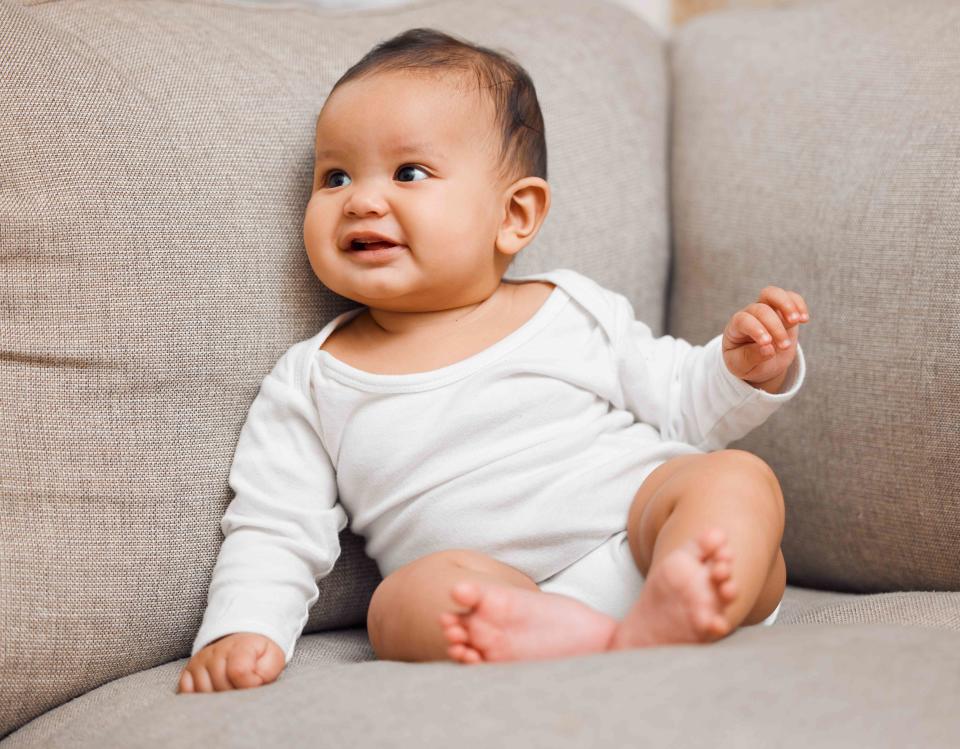Why You Shouldn’t Velcro Your Baby to Any Type of Seat
Experts weigh in on this unsafe trick that's going viral.

PeopleImages / Getty Images
Fact checked by Sarah Scott
This is a joke, right?
That might have been your first thought upon reading the headline of this piece. But a mom on TikTok shares what she deems “the best airplane travel hack,” and it’s gone viral.
In the video, which has more than 16 million views, the parent is seen placing Velcro on both her child and an airplane seat in order to get the kid to stay put. Some commenters are loving this technique, but experts say Velcro should never be used to restrain a child to any seat. It's not safe.
Look, traveling with kids, especially younger ones, isn’t easy. But strapping a child to a seat like this can lead to injury.
A much safer option includes placing your child in a car seat on a plane. The American Academy of Pediatrics (AAP) recommends all babies and toddlers use a rear-facing car seat on a plane until they reach the highest weight and height for it. Then they can switch to a forward-facing car seat. If you can’t bring a car seat onboard, opt for an airplane harness device approved by the Federal Aviation Administration (FAA).
This isn't the first time the idea of using Velcro to keep a child on a seat has gone viral. Earlier in 2024, this same TikTok parent shared a video Velcroing her baby to a couch.
In the 60-second clip, the mother puts Velcro on the infant’s shirt and a cushy sofa. She doesn’t exit the room. Instead, she plays with a toy cupcake, which her child gleefully reaches toward. After Velcro playtime, the mother removes the strips from the sofa and the baby.
“Is this legal?” one commenter asked.
It's not a good idea, that's for sure. We asked pediatricians and safety experts to weigh in on why and give actual, safe “hacks” for keeping a child in one place.
Why Using Velcro in This Way Is Unsafe
Listen, parenting is hard. My second child learned how to jump a baby gate, which easily deterred my first, and climbed the stairs before he turned a year old. It’s stressful when you’re home alone with children and housework and cooking-related tasks call. And when you’re outnumbered? Ugh.
Yet, the fact remains: Velcroing an infant to furniture or an airplane seat during travel is not the way.
“I understand you're curious about using Velcro to restrain a child, but it's important to know that this is not a safe or appropriate practice,” says Daniel Ganjian, MD, FAAP, a board-certified pediatrician at Providence Saint John’s Health Center in Santa Monica, California.
Why, might you ask?
“Velcro is definitely not a safety-approved device to hold children,” says Kelly J. Moriarty, DNP, MSN, RN, the injury prevention coordinator with Novant Health PMC Trauma Services. "It is not sturdy or reliable."
Velcro will not be able to restrain most infants. "And the Velcro can easily loosen, or the clothes can loosen or come off," adds Moriarty.
Because it’s not sturdy or reliable, Moriarty says Velcroing a baby to a couch puts the little one at risk for:
Falls
Choking
Strangulation
“If the child slides down, they can basically be hung by the shirt, [which] may or may not cause injury but is not a risk I would take,” Moriarty says.
Additionally, Moriarty says parents may gain a false sense of security about leaving an infant unattended, only heightening all of the above risks.
The possibility of injury and death would hopefully be enough of a deterrent to steer clear of this horrible hack. However, pediatricians share that the practice is problematic for even more reasons, starting with development.
“Restricting a child's movement can hinder their physical and cognitive development,” Dr. Ganjian says. “They need freedom to explore and learn through movement.”
Finally, it’s just not nice: “Restraining a baby in this way is likely to cause frustration,” explains Amanda Stovall, MD, an Illinois-based pediatrician.
What Parents Can Do Instead
Parents who need a child to stay put can consider alternatives, such as:
Laying a child on a floor on a baby mat
Baby-wearing using a carrier or wrap
When on a plane, using a car seat or FAA-approved harness device
“These are approved and generally tested for safety,” Moriarty says. “They also reduce the risk of falling from a height, which can lead to injury. Please note, it is important to use all safety features, such as buckles or straps, when using [carriers and wraps] and keep warranties and check for recalls.”
Even in products considered safe, Dr. Ganjian says it’s best to supervise an infant. (Great news: Pack ‘n plays and baby mats are portable, so you can have them in the kitchen while you cook or in the bedroom as you fold laundry—or don’t fold it.)
Finally, soaking up all the snuggles on the couch with an infant who is not Velcroed to anyone or anything (except figuratively speaking to a loving parent) can be a great way to bond. However, Dr. Stovall shares some tips to make snuggle time safer:
“It is not safe to allow babies to sleep on the couch, or for parents and babies to sleep on the couch together due to the risk of SIDS, suffocation, or potentially falling and getting trapped,” Dr. Stovall says. “If your family spends a lot of time on and around the couch, you may want to take a look at what else is in the immediate area, such as coffee tables, that may have sharp corners as further protection.”
Consider these hacks you can use.
For more Parents news, make sure to sign up for our newsletter!
Read the original article on Parents.

